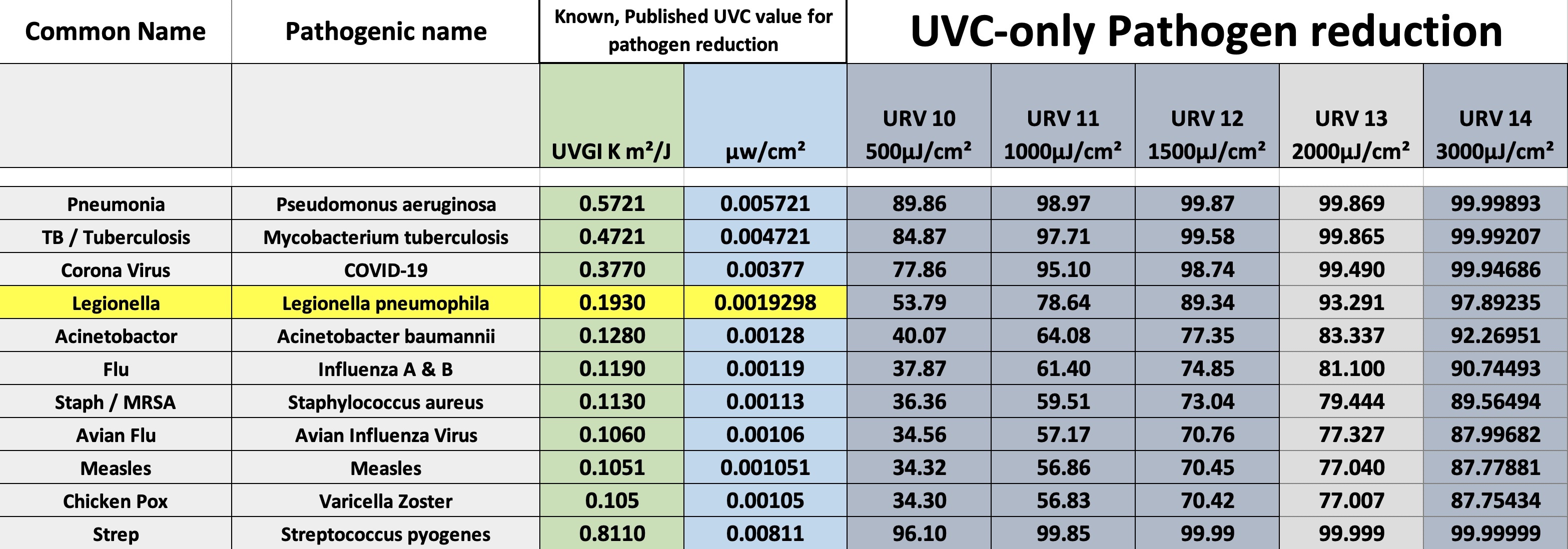
Legionella In Summer Months
Historically, starting in June and peaking in July, large cities such as Chicago and New York see a significant increase in Legionella cases and deaths. With the timing of the recent wildfires (June 2023) causing problems with the air quality, this summer’s Legionella numbers could be impacted, making it especially important to consider strategies to address the aerosolized bacteria.
UVC is an effective option.
According to the CDC, health departments reported nearly 10,000 cases of Legionnaires' disease in the United States in 2018. However, because Legionnaires' disease is likely underdiagnosed, this number may underestimate the true incidence. Source CDC.gov
Legionella is bacteria that grows from water but is only dangerous once it is aerosolized and then aspirated, making fresh air intake UVC applications ideal in large, metropolitan areas.
- Note that legionella is not spread from person to person except in very rare circumstances. The spread of Legionella is strictly due to conditions and quality of the air.
- Legionella is largely under diagnosed and people at increased risk of getting sick include those 50 years or older and those with weak immune systems.” Source CDC.gov
- In normal circumstances, Legionella is fatal in 1 out of 10 cases.
Legionella is highly susceptible to UVC and is inactivated at a high rate even at low doses.
UVC disinfection (or pathogen inactivation) is a simple function of intensity over time. Lumalier UVC fixtures can inactivate any known airborne pathogen to meet any client demand; even 80%, 90% or more…per air pass!

Note: These calculations are based off of the International UV Associations URV standard and Dr. Kowalski’s Ultraviolet Germicidal Irradiation Handbook.
Lumalier spaces our lamps at appropriate distances to create the UVC intensity level needed to disinfect the air, even when air is moving at high speeds through an air handler. We evaluate each application and engineer our systems to meet the requirements.
Calculating Disinfection Rates: Lumalier's Client-Based, Science-Driven Approach
When it comes to UVC, it's not one size fits all. What numbers are needed for effective calculations?
When looking at in-duct UVC systems, there are a number of factors that need to be considered when determining the correct UV product configuration and UVC dosage to apply:
- Area being addressed
- Air speed of the air handler
- Dwell time
- Disinfection requirements
While it may sound complicated, it's really just a matter of doing the math, and with over 60 years of experience, we're here to help! Contact us to learn more about the solutions for your applications.
Background
What is Legionnaires' disease and how does it spread through HVAC units?
Legionnaires' disease is a severe form of pneumonia caused by the bacterium Legionella pneumophila. It was named after an outbreak in 1976, during a convention of the American Legion in Philadelphia, where the disease was first identified.
Legionella bacteria are commonly found in natural water sources like lakes and streams. They thrive and multiply in warm, stagnant water environments. Legionnaires' disease is typically contracted by inhaling small droplets of water containing the Legionella bacteria, rather than through person-to-person transmission.
HVAC (Heating, Ventilation, and Air Conditioning) units, particularly cooling towers, have been associated with outbreaks of Legionnaires' disease. Here's how the bacteria can spread through HVAC systems:
- Contaminated water source: If the water supply that feeds the HVAC system becomes contaminated with Legionella bacteria, the risk of spreading the disease increases. The bacteria can enter the system through various means, such as municipal water supplies, natural water sources, or improperly maintained water storage tanks.
- Cooling towers: Cooling towers are large, open-air systems used to cool water for air conditioning purposes. They provide an ideal environment for Legionella growth due to the warm, moist conditions. The bacteria can multiply in the water and then spread into the surrounding air as aerosolized droplets. If these contaminated droplets are then inhaled by individuals nearby, they may contract Legionnaires' disease.
- Air handling units: In some cases, Legionella bacteria can colonize and grow in the water within the air handling units of HVAC systems. These units are responsible for distributing conditioned air throughout buildings. If the Legionella-contaminated water comes into contact with the air supply or evaporator coils, the bacteria can be aerosolized and subsequently inhaled.
- Distribution systems: The ductwork and piping within HVAC systems can act as conduits for the spread of Legionella bacteria. If the bacteria have colonized within the system, they can be transported through the air or water flows, potentially reaching different areas of a building, and exposing occupants to the bacteria.
To help prevent Legionnaires' disease spread through HVAC systems, regular maintenance and proper water treatment are essential. This includes routine cleaning, disinfection, and monitoring of water supplies, cooling towers, air handling units, and distribution systems. It's crucial to adhere to established guidelines and regulations to minimize the risk of Legionella contamination and ensure the safety of building occupants.
In-Duct/In-AHU UVC for Legionella Inactivation
In-Duct/In-AHU fixtures, such as Lumalier’s AR Series, are engineered to be customizable to fit any size AHU and address any level of pathogen reduction. With an appropriate dosage, UVC can help to mitigate the risk of aerosolized Legionella bacteria in the air, which can be subsequently inhaled and cause disease.
